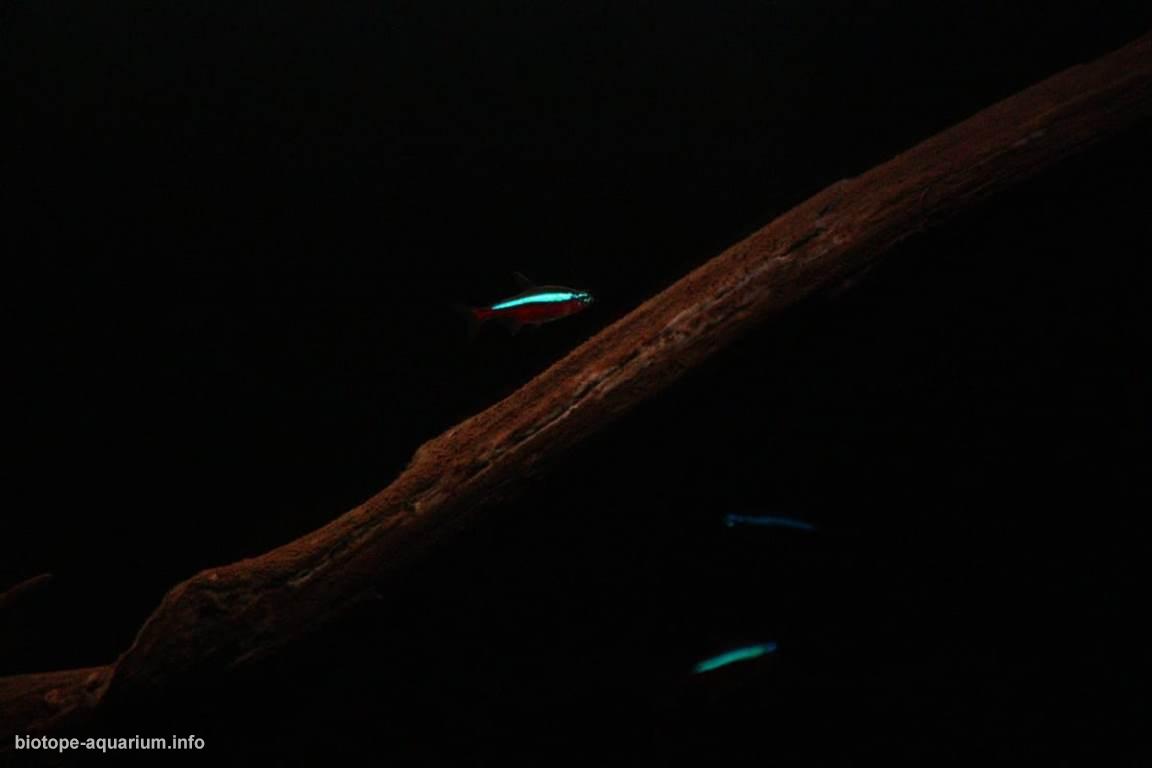
Small stream margin, near Raidāk River, Brahmaputra River Drainage, India
03.01.2022
Volume of aquarium: 54 liters
Dimensions of aquarium: 60x30x30 cm
List of fishes: Paracheirodon axelrodi
List of plants: –
Description of Decorations and Substrate: The substrate is made of fine sand and covered with leaves, leaf litter, branches and driftwood.
Description of Equipment: The filtration is based on Juwel “Bioflow One” with waterflow about 300 L/h. The lighting of aquarium is based on Juwel “PrimoLux” (1x4w). A heater of 50w cares for the temperature.
Water Parameters:
Temperature: 25°C
ph: 6,8
gh: 4
kh: 3
Additional Info: Weekly water change of 15%
Aquarium video::
Description of the Area Surrounding the Biotope: The Rio Negro, which means “the black river,” is the largest tributary of the North Bank of the Amazon River. The total length of the Negro River is 2550-2252.6km, the drainage area is 620000 square kilometers, the annual average flow is 30000 cubic meters / second, the average annual runoff depth is 1600mm, and the suspended load concentration is 0.007 kg / m3. The Rio Negro is a seasonal river in the sense that it has fairly predictable seasonal fluctuations in water level during most years. It begins raining earlier in the lower Rio Negro drainage than in its upper reaches. The rainiest months in the lower Rio Negro are between December and May, whereas in the middle course they are between March and July. The river course twists and turns. As you move deeper into the dense ‘terra firme’ forest you can find many small shallow rivers or forest streams, also known locally as an ‘igarapé’, slowly flowing through the dense forest. There is a presence of overhanging riparian vegetation and many fallen leaves and twigs on the ground. You can hear many birds singing in the background. One of the small tributaries is barcelos, located near Barcelona. It is located deep in the Amazon rainforest. It is covered with rain and needs to be rowed in by boat.
Description of the Underwater Landscape of the Biotope: The Rio Negro and its many tributaries are stained by humic acids or compounds due to immense layers of leaves and twigs. Igarapés are characterised by thick, often overhanging, riparian vegetation and substrates covered in fallen branches, tree roots and leaf litter. Therefore it has its unique dark color, ranging from light brown to almost entirely black. The tropical sun is streaming in through the canopy just to light up a few places in the water. The water is shallow, less than 1 meter in most places, and the bottom is thoroughly covered with leaf litter. The sheer density of fish is therefore incredible. It’s also likely that just a few dozen kilometers further down there is another igarapé that contains a completely different set of species from the previous one, and often including species not found anywhere else in the Amazon. It happens that igarapés are extremely diverse in aquatic fauna and very distinct from one another.
Description of the Habitat Parameters: The conductivity is somewhere between 8-10 µS/cm. The pH ranges from about 3.6-5.8, depending on the exact site and time of the year. The water temperature in the rainy season is about 26.5-28°C. In the dry season the water temperature is about 28.5-30°C.
List of Fishes and Invertebrates Occurring in the Nature Biotope:
Paracheirodon axelrodi
Hemigrammus bleheri
Hyphessobrycon pyrrhonotus
Prionobrama filigera
Crenuchus spilurus
Nanostomus eques
Nannostomus beckford
Poecilocharax weitzmani
Liosomadoras oncinus
Dicrossus filamentosus
Crenicichla notophthalmus
Mesonauta festivus
List of Plants Found in the Nature Biotope: –
Threats to the Ecology of the Biotope: There are many threats to the Amazon rainforest, like goldmining, hydroelectric dams and agriculture, which cause massive deforestations and endangering the lives of local populations.
Sources of Information:
http://www.reef2rainforest.com/2017/01/09/biotope-video-blackwater-shallows-in-the-middle-rio-negro
https://rainforests.mongabay.com/0602.htm
http://www.tfhmagazine.com/details/articles/fishing-with-the-piabeiros-of-brazils-rio-negro-full-article.htm
http://www.reef2rainforest.com/2016/12/09/biotope-video-cichlid-heaven-in-the-lower-rio-negro
https://en.wikipedia.org/wiki/Rio_Negro
Paracheirodon axelrodi – Cardinal Tetra (Cheirodon axelrodi, Hyphessobrycon cardinalis)
Photo 2:

Photo 3:

Photo 4:

Photo 5:

Photo 6:
